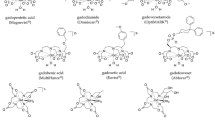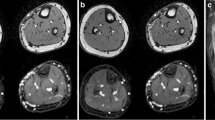Abstract
This review introduces the basic principles of contrast-enhanced magnetic resonance (MR) angiography and details four contrast-enhanced MR angiography sequences for body imaging with extracellular gadolinium-based contrast agents in pediatric patients. Specifically, this review covers (1) respiratory-navigated, cardiac-gated MR angiography; (2) time-resolved MR angiography; (3) conventional MR angiography; and (4) modified spoiled gradient echo variants. We present and discuss indications, technical considerations, sequence optimization, advantages and disadvantages, along with practical tips and illustrative case examples for each sequence.








Similar content being viewed by others
References
Prince MR (1994) Gadolinium-enhanced MR aortography. Radiology 191:155–164
Hashemi RH, Bradley WG, Lisanti CJ (2018) MRI the basics. Wolters Kluwer Health, Philadelphia, p xiv
Wehrli FW (1990) Time-of-flight effects in MR imaging of flow. Magn Reson Med 14:187–193
Haase A, Frahm J, Matthaei D et al (2011) FLASH imaging: rapid NMR imaging using low flip-angle pulses. 1986. J Magn Reson 213:533–541
Winkler ML, Ortendahl DA, Mills TC et al (1988) Characteristics of partial flip angle and gradient reversal MR imaging. Radiology 166:17–26
Kopka L, Vosshenrich R, Rodenwaldt J, Grabbe E (1998) Differences in injection rates on contrast-enhanced breath-hold three-dimensional MR angiography. AJR Am J Roentgenol 170:345–348
Menke J (2009) Carotid MR angiography with traditional bolus timing: clinical observations and Fourier-based modelling of contrast kinetics. Eur Radiol 19:2654–2662
Carroll TJ, Korosec FR, Swan JS et al (2001) The effect of injection rate on time-resolved contrast-enhanced peripheral MRA. J Magn Reson Imaging 14:401–410
Yoo SJ, Lam CZ, Hussein N, Van Arsdell G (2019) From multiplanar imaging to physical 3D models: 3D printing as an adjunct to congenital heart surgery. In: Zahn EM (ed) 3-dimensional modeling in cardiovascular disease. Elsevier, Waltham, pp 43–54
Kourtidou S, Jones MR, Moore RA et al (2019) mDixon ECG-gated 3-dimensional cardiovascular magnetic resonance angiography in patients with congenital cardiovascular disease. J Cardiovasc Magn Reson 21:52
Tandon A, James L, Henningsson M et al (2016) A clinical combined gadobutrol bolus and slow infusion protocol enabling angiography, inversion recovery whole heart, and late gadolinium enhancement imaging in a single study. J Cardiovasc Magn Reson 18:66
Fratz S, Chung T, Greil GF et al (2013) Guidelines and protocols for cardiovascular magnetic resonance in children and adults with congenital heart disease: SCMR expert consensus group on congenital heart disease. J Cardiovasc Magn Reson 15:51
Lam CZ, Pagano JJ, Gill N et al (2019) Dual phase infusion with bolus tracking: technical innovation for cardiac and respiratory navigated magnetic resonance angiography using extracellular contrast. Pediatr Radiol 49:399–406
Blackham KA, Passalacqua MA, Sandhu GS et al (2011) Applications of time-resolved MR angiography. AJR Am J Roentgenol 196:W613–W620
Willinek WA, Hadizadeh DR, von Falkenhausen M et al (2008) 4D time-resolved MR angiography with keyhole (4D-TRAK): more than 60 times accelerated MRA using a combination of CENTRA, keyhole, and SENSE at 3.0T. J Magn Reson Imaging 27:1455–1460
Maki JH, Prince MR, Chenevert TC (1998) Optimizing three-dimensional gadolinium-enhanced magnetic resonance angiography. Original investigation. Investig Radiol 33:528–537
Clark TJ, Wilson GJ, Maki JH (2017) Effect of injection rate on contrast-enhanced MR angiography image quality: modulation transfer function analysis. Magn Reson Med 78:357–369
Maki JH, Prince MR, Londy FJ, Chenevert TL (1996) The effects of time varying intravascular signal intensity and k-space acquisition order on three-dimensional MR angiography image quality. J Magn Reson Imaging 6:642–651
Zhang H, Maki JH, Prince MR (2007) 3D contrast-enhanced MR angiography. J Magn Reson Imaging 25:13–25
Earls JP, Rofsky NM, DeCorato DR et al (1996) Breath-hold single-dose gadolinium-enhanced three-dimensional MR aortography: usefulness of a timing examination and MR power injector. Radiology 201:705–710
Rofsky NM, Lee VS, Laub G et al (1999) Abdominal MR imaging with a volumetric interpolated breath-hold examination. Radiology 212:876–884
Bader TR, Semelka RC, Pedro MS et al (2002) Magnetic resonance imaging of pulmonary parenchymal disease using a modified breath-hold 3D gradient-echo technique: initial observations. J Magn Reson Imaging 15:31–38
Semelka RC, Cem Balci N, Wilber KP et al (2000) Breath-hold 3D gradient-echo MR imaging of the lung parenchyma: evaluation of reproducibility of image quality in normals and preliminary observations in patients with disease. J Magn Reson Imaging 11:195–200
Author information
Authors and Affiliations
Corresponding author
Ethics declarations
Conflicts of interest
None
Additional information
Publisher’s note
Springer Nature remains neutral with regard to jurisdictional claims in published maps and institutional affiliations.
Supplementary Information
Online Supplementary Material 1
Movie of coronal navigated contrast-enhanced MR angiography in a 10-year-old boy with Ebstein anomaly who underwent a cone procedure (MP4 23,970 kb)
Online Supplementary Material 2
Excel calculator to determine injection rates and program power injector for performing navigated contrast-enhanced MR angiography (XLSX 10 kb)
Online Supplementary Material 3
Movie of coronal time-resolved contrast-enhanced MR angiography subtraction maximum-intensity projections in a 7-year-old boy with a congenital arteriovenous malformation of the left thigh. Temporal resolution was 5 s with a total of 40 acquisitions (MP4 2,168 kb)
Online Supplementary Material 4
Movie of coronal time-resolved contrast-enhanced MR angiography subtraction maximum-intensity projections in a 6-year-old girl with intestinal failure shows chronic occlusion of the right axillary, subclavian and internal jugular veins along with severe stenoses of the bilateral brachiocephalic veins and superior vena cava (SVC). There is collateral venous drainage of the upper body to the infrarenal inferior vena cava (IVC) via the azygos vein and paravertebral system. Temporal resolution was approximately 2 s with a total of 60 acquisitions (MP4 9,881 kb)
Rights and permissions
About this article
Cite this article
Aguet, J., Gill, N., Tassos, V.P. et al. Contrast-enhanced body magnetic resonance angiography: how we do it. Pediatr Radiol 52, 262–270 (2022). https://doi.org/10.1007/s00247-021-05020-z
Received:
Revised:
Accepted:
Published:
Issue Date:
DOI: https://doi.org/10.1007/s00247-021-05020-z




